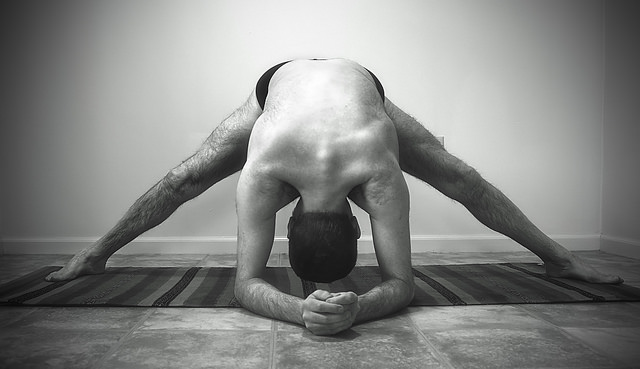
Warning: naughty language ahead!
We’ve all seen the ads: happy, beautiful young women in gorgeous clothes, smiling while doing killer poses.
We’re selling yoga. We’re selling beauty. We’re selling happiness.
We’re all selling.
And selling—by definition—sells happy. Only happy. The rishis tell us so.
So, we may imagine that modern industrial yoga doesn’t support the sale of Prozac, Xanax and Ritalin, but it does, because it sells an ideal of the real that can be chased, but not caught.
The rabbit wheel of existence that includes happy includes sad, too.
Yes, I am raining on your yoga parade. I am raining on your market-driven view of existence.
In the old texts we see a world described as dual. The binary eyes of the rational mind can see only a world of opposites.
The Bhagavad Gita says,
“Oh Arjuna!, Happiness and unhappiness comes and goes
It is impermanent. Strive toward equanimity
Indeed, the person untroubled by these opposites
The wise person for whom these are the same, that one is prepared for the Ultimate Freedom”
(BG 2:14-15)
In other texts, we get a stratification of society that relates to caste and happiness, sort of like a modern personality assessment:
1) The worker caste, Sudras, with a limited view of human potential, see the world as evil and unhappy. (They think the system is rigged and unfair, they’re a victim, and someone is always out to get them.)
2) The merchant caste, Vaishyas, see the world as good and happy. They think every problem can be fixed by an idea or a product. Mercantilism must run on happiness. Products are pitched as salves for this moment’s lack of pleasure. This is the genius of the Vaishya.
3) The administrative caste, Kshatriyas, see the world as rich and poor, good and evil, happy and sad, and they play one off against the other to maintain the status quo.
Think of politicians who must make hard choices to favor one option over others for the greater good, or policemen or soldiers who must use violence to achieve social stability. This is the world of negotiation, diplomacy and trade-offs. This is where a finite world demands painful and often heroic choices.
4) The priestly, mystic, or spiritual caste, the Brahmins, also see the world as good and evil, happy and sad, but their view transcends the opposites. They see how they interweave and change faces, and become one another. They see everything as yoga (“union”). They see everything in the created world as both good and evil. (Yes, Hitler, too. Yes, puppies, too. Yes, climate-change deniers, too.)
The Brahmin view sees reality as it is, accepts it as it is and takes a disinterested view toward changing it—because it is perfect “as it is.”
This last worldview is a hard one to take for us in our modern activist political modes. We believe that society can solve all life’s ills. We believe we can create a social order that is only good, that is only happy.
Truly, this is a noble and necessary option, and really the only one we can have, but if we think our attainments won’t be tainted, we must take care.
Part of our striving for social perfection comes from our historical life in the age of the Vaishyas. The tradition tell us that we live in an epoch ruled by the Merchant Class.
We naturally believe that society can dodge all duality and make “happy” its chief product; hence, our industrial form of yoga meets that need—and promises happy, happy, happy.
But yoga tells us this is an “eccentric” view. It is “outside the circle.” It is a view beyond wholeness.
Duality always kicks back, and industrial yoga can offer us artificial feel-good moments and not a stitch more. In class, we see all those gorgeous asses, and all those kick-ass pants, and we buy the lie and seek a Zoloft or a double mocha latte on our slouch home.
Baby, don’t do that with your yoga.
Yoga was designed for that last option of the Brahmins. It’s designed to get us beyond good and evil.
Yoga blows your mind and builds your body and teaches you freedom from the whipping wheel of existence by making you sit with sad, and sit with shit, and sit with your gorgeous capacities to forgive the world for being silly and slick and disagreeable, and to love it sweetly and wisely with the enveloping eye of the Brahmin as your guide.
Practice for this. Meditate for this. Guide the breath for this.
Live for fullness, not a delusional eccentricity. This is your inner marketing success. Do some real yoga that makes you sit with the shit of the real…and love your way beyond the good, the evil, and the blindness of our current age.
Relephant Read:
Krishna’s 10 Definitions of Yoga in the Bhagavad Gita.
~
Author: Eric Shaw
Editor: Catherine Monkman
Photo: Nicholas A. Tonelli/Flickr
~
 Share on bsky
Share on bsky

Read 2 comments and reply